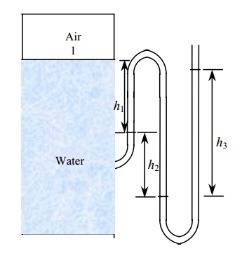
Physics, 01.08.2019 12:00, stephany739
The water in a tank is pressurized by air, and the pressure is measured by a multi-fluid manometer as shown. determine the gage pressure of air in the tank if h1 = 0.2 m, h2 = 0.3 m, and h3 = 0.46 m. take the densities of water, oil, and mercury to be 1000 kg/m3 , 850 kg/m3 , and 13,600 kg/m3 , respectively

Answers: 2
Other questions on the subject: Physics

Physics, 21.06.2019 17:30, stryjker
The ballistic pendulum was invented in 1742 by english mathematician benjamin robins. it consists of an initially stationary pendulum that moves after being struck by a bullet, and it is used to measure the original velocity of the bullet. the known variables are the bullet's mass m, the pendulum's mass m, and the height to which the block and bullet swing, determined by the length of the pendulum l and final angle θ. two principles of physics are necessary to solve for the bullet's original velocity. what are these principles? conservation of momentum and newton's third law conservation of energy and conservation of angular momentum grade summary deductions 0% potential 100% conservation of momentum and newton's second law. newton's second law and conservation of angular momentum. conservation of energy and newton's third law conservation of momentum and conservation of angular momentum. conservation of momentum and conservation of energy conservation of energy and newton's second law.
Answers: 2

Physics, 21.06.2019 22:30, IDespretlyneedhelp
Solar cell a produces 100 joules of energy, when a light source is shown on it for 3 minutes. solar cell b produces 200 joules of energy when the same light source is shown on it for 5 minutes. which solar cell works better? a) solar cell b, because it produces more energy. b) solar cell b, because it generates more power. c) solar cell a, because it produces energy quicker. d) solar cell a, because it generates a greater wattage. eliminate
Answers: 2

Physics, 22.06.2019 00:30, powberier6979
Consider an ordinary, helium-filled party balloon with a volume of 2.2 ft3. the lifting force on the balloon due to the outside air is the net resultant of the pressure distribution exerted on the exterior surface of the balloon. using this fact, we can derive archimedes’ principle, namely that the upward force on the balloon is equal to the weight of the air displaced by the balloon. assuming that the balloon is at sea level, where the air density is 0.002377 slug/ft3, calculate the maximum weight that can be lifted by the balloon. note: the molecular weight of air is 28.8 and that of helium is 4.
Answers: 2
Do you know the correct answer?
The water in a tank is pressurized by air, and the pressure is measured by a multi-fluid manometer a...
Questions in other subjects:


Biology, 30.08.2019 12:00



History, 30.08.2019 12:00


Mathematics, 30.08.2019 12:00



Social Studies, 30.08.2019 12:00







